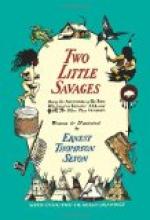Fig. 10. The finished Owl, with the thread wrappings on and the wires still projecting; Nw is end of the neck wire; Bp is back-pin—that is, the wire in the center of the back; Ww and Ww are the wing wires; Tl are the cards pinned on the tail to hold it flat while it dries. The last operation is to remove the threads and cut all the wires off close so that the feathers hide what remains.
While they were so working Sam had busied himself opening the Owls’ stomachs—“looking up their records,” as he called it. He now reported that one had lynched a young Partridge and the other had killed a Rabbit for its latest meal.
Next night Si Lee came as promised, but brought bad news. He had failed to find the glass Owl eyes he had hoped were in his trunk. His ingenuity, however, was of the kind that is never balked in a small matter. He produced some black and yellow oil paints, explaining, “Guess we’ll make wooden eyes do for the present, an’ when you get to town you can put glass ones in their place.” So Sam was set to work whittling four wooden eyes the shape of well-raised buns and about three-quarters of an inch across. When whittled, scraped and smooth, Si painted them brilliant yellow with a central black spot and put them away to dry (shown on a large scale on Owl Stuffing Plate, Fig. 9, a and b).
Meanwhile, he and Yan got out the two skins. The bloody feathers on the breasts were washed clean in a cup of warm water, then dried with cotton and dusted all over with meal to soak up any moisture left. The leg and wing bones were now wrapped with as much tow as would take the place of the removed meat. The eye sockets were partly filled with cotton, then a long soft roll of tow about the length and thickness of the original neck was worked up into the neck skin and into the skull and left hanging. The ends of the two wing bones were fastened two inches apart with a shackle of strong string (X, Fig. 2 and Fig. 7). Now the body was needed.
For this Si rolled and lashed a wad of tow with strong thread until he made a dummy of the same size and shape as the body taken out, squeezing and sewing it into a hard solid mass. Next he cut about two and a half feet of the large wire, filed both ends sharp, doubled about four inches of one end back in a hook (Fig. 5), then drove the long end through the tow body from the tail end out where the neck should join on (Figs. 3 and 4). This was driven well in so that the short end of the hook was buried out of sight. Now Si passed the projecting ends of the long wire up the neck in the middle of the tow roll or neck already there, worked it through the skull and out at the top of the Owl’s head, and got the tow body properly placed in the skin with the string that bound the wing bones across the back (X, Fig. 7).
Two heavy wires each eighteen inches long and sharp at one end were needed for the legs. These were worked up one through the sole of each foot under the skin of the leg behind (Lw, Fig. 6), then through the tow body at the middle of the side (W, Fig. 7), after which the sharp end was bent with pliers into a hook and driven back into the hard body (after the manner of the neck wire, Fig. 4).




